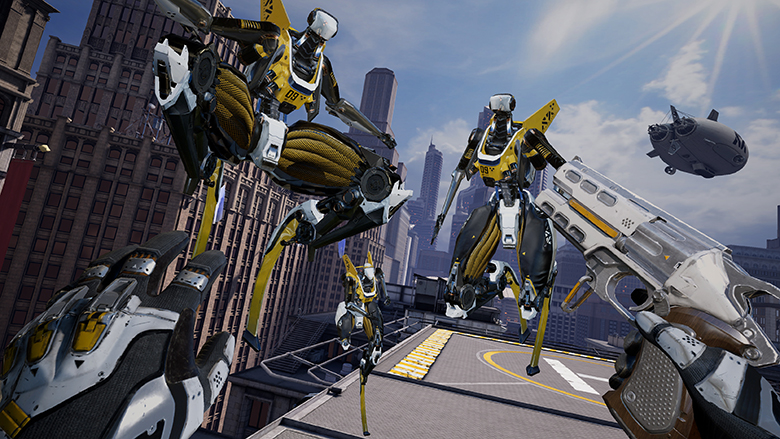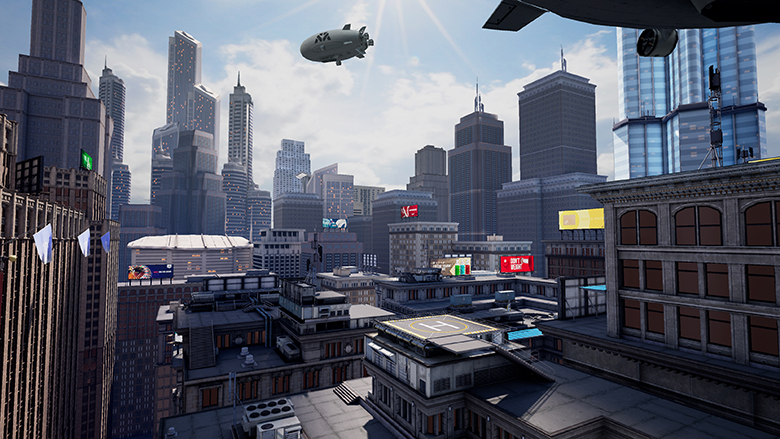There’s a considerable gap in the VR market that the new Oculus Quest – set for a Spring release at $399 – is looking to fill. Designed for people who want a headset geared towards a gaming experience but lacking the high-end PC and are unwilling to part with a hefty chunk of change, the Quest is an all-in-one wireless solution that features room-size VR and motion controls but without these restrictive costs. It’s an impressive bit of kit, with Oculus talking about cross-play with Rift owners and cross-buy across both products, but at the same price as the new Rift S, set to be released at the same time, is it a neutered experience when stripped of the need for a monster PC?
We had the chance to try out the headset, playing Robo Recall, an arcade style FPS that came out in 2017 to fair acclaim, and the results were pretty impressive. Epic Games was behind the original Recall, but Gunheart dev Drifter handled this.
As one of the more graphically impressive titles on the VR marketplace, there’s an expectation to see some of this visual fidelity would be stripped away to ensure it ran at a solid clip on this headset, but nope – Robo Recall looks pretty damn good running on the Quest. We had previously seen a snippet of the game that looked pretty blurry, but since-released images promise more of a visual feast.
There’s a few minor graphical changes to keep things ticking over on the headset, however. Lighting and other effects appear to have been dialed back a bit, and during the first stage there appears to be a little bit less going on in the background of the city than in original, PC-based release. It’s a similar trick that PSVR titles utilise, like Gran Turismo – a loss of fidelity in areas where you’re not paying close attention to, to keep the areas you’re forced to pay attention to looking their best.
It’s still an extremely fun shooter. Robo Recall is a game that focuses on providing a thrill-a-minute experience rather than attempting to simulate a real firefight. Pistols are perpetually strapped to your belt so there’s no need to reload, just chuck your current pair away (or, at an enemy, if you’re going for some galaxy brain thinking) and grab two fresh ones! You always have a sub weapon strapped to your back and reaching over your shoulder for a shotgun makes you feel like the actual Terminator. Plucking bullets out of the air and throwing them back at enemies like you’re some kind of darts-playing Neo just doesn’t get old.
The real stars of Robo Recall, perhaps unsurprisingly, are the enemy robots themselves. With enough variety to keep them interesting and keep you – literally – on your toes, they provide you with a bunch of targets that feel really, really satisfying to take out. Pinging one with a headshot from distance and sending their dome clean off, using a shotgun blast to evaporate a few leaping spider-robots that got a bit too close or juggling an enemy repeatedly on a hail of gunfire, racking up a multiplier bonus with every successful keepie up.
Robo Recall’s cherry on the combat cake, however, is when one of these enemy robots has the audacity to get right up into your personal space. You then have the ability to grab them and tear them apart with your bare hands. Grab a leg and an arm and pull them in two! Grab them by the handle on their torso and bash them into the ground! Actually RIP their face right off! It’s such a fun feature and makes you feel great – the real thing you want from a VR action game.
It’s all very much a continuation of the arcade lightgun shooter genre – a genre that has sadly been forgotten in recent years due to the need for big old CRT screens in order for the lightgun to actually work, and it’s great that as their reliance on an old technology threatens to condemn them to the history books, they find a potential new home in some cutting edge new one.
It takes a bit of getting used to. This game is running ON the headset. Similar all-in-one VR products, like the Google Daydream or Samsung products for smartphones offer a similar setup, but the quality of visuals just isn’t a patch on the Quest.
Like those headsets, however, there’s a few concerns. First of all, it’s a heavier piece of kit than the Rift S. Completely expected due to the added components needed to allow for an all-in-one VR solution and with clear ergonomic design to negate as much of this as possible. It also heats up, due to the battery powering the device, there was some discomfort with prolonged use.
The $399 price point is competitive – it’s easy to forget how much a smartphone actually costs when most people take contracts out – and is all you need to get started with Oculus Quest. There’s no hidden extras. It is still expensive, but the pick up and play nature of the Quest is going to attract those who want a VR experience free of a gaming PC. With the store being curated by Oculus rather than the wild west approach on the Rift store (which allows for a lot more early access titles and experimental bits and pieces, admittedly) Oculus are making every effort to position this as a quick and easy way to jump into the VR world. It’s a large market – if anything can capture it, it will be something like the Quest.

























